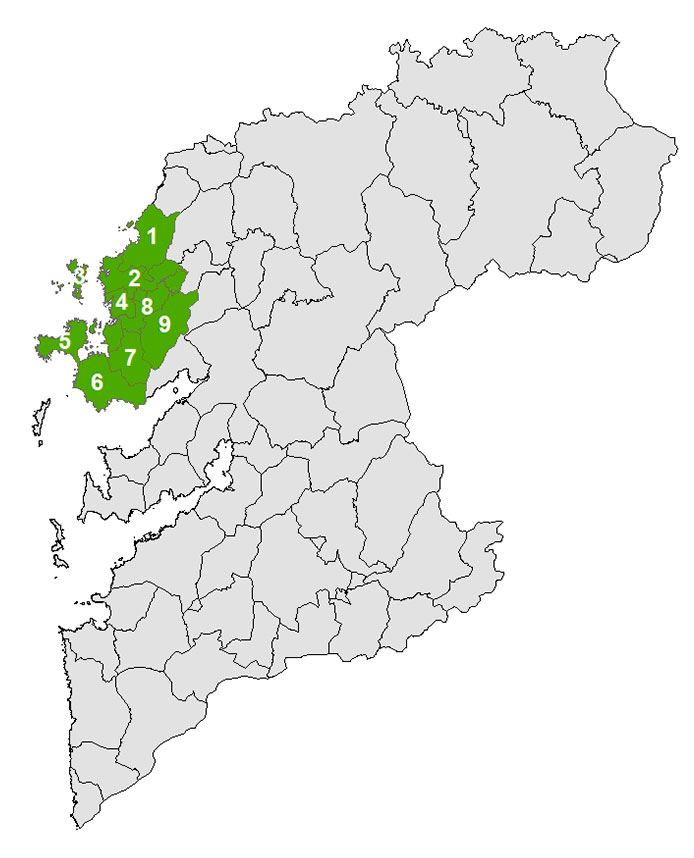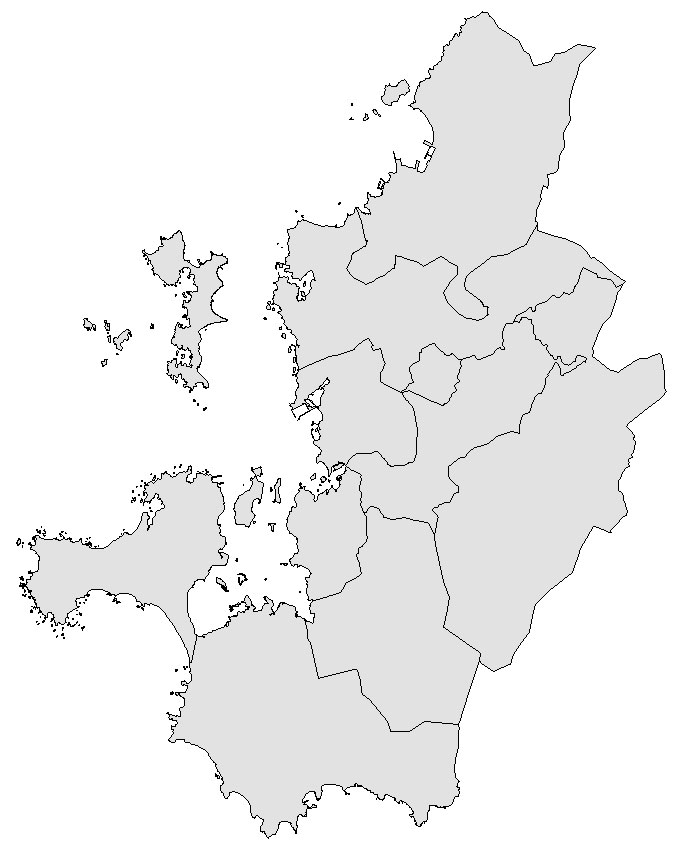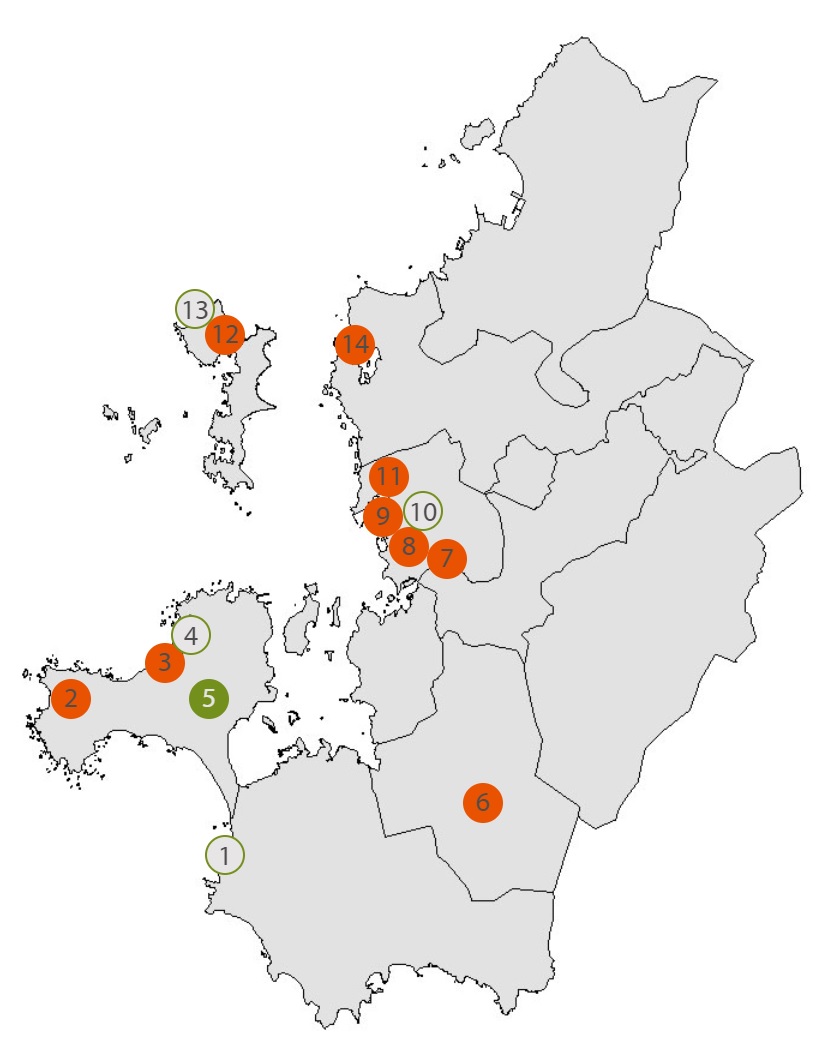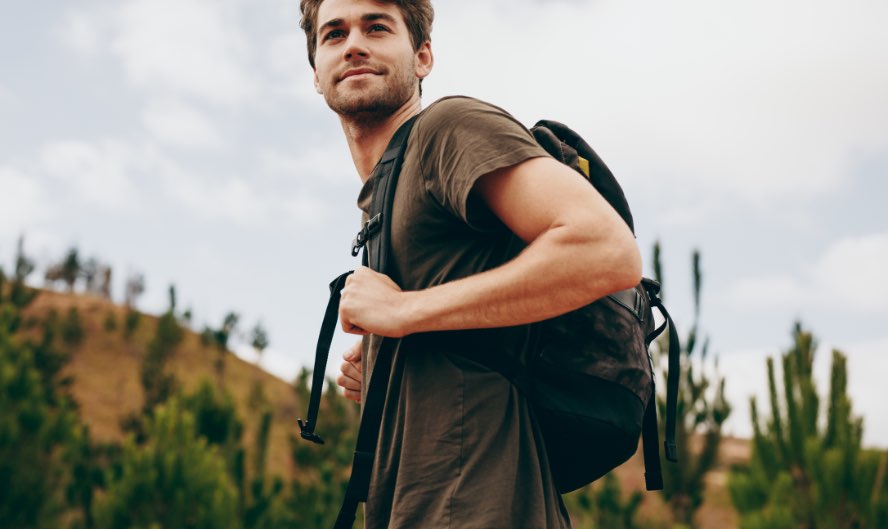09.EXPERIENCE THE REGION OF O SALNÉS
OF SEA AND WINE
OF SEA AND WINE
Discover a region where the vineyards overlook the sea, as a combination of ocean and land. The placid natural landscapes and sea life merge with orchards, beautiful gardens and productive vineyards. The manor houses, popularly known as pazos, and wineries are scattered all over the region. In this land, throughout history the pre-Roman settlements, castles and monasteries have dominated a landscape with a very distinct character.
In O Salnés you can get to know the bustling small towns of Sanxenxo, Meaño, O Grove, Cambados, Ribadumia, Meis, A Illa de Arousa, Vilanova de Arousa and Vilagarcía de Arousa. All of them enjoy a great economic diversity and a marked character, in which sea and land merge to create a unique landscape.
On the coast, besides fishing and shellfish harvesting, there are orchards and vineyards that produce high-quality wines. Cambados, with its Museo Etnográfico do Viño (Ethnographic Museum of the Wine), is the main winegrowing town in the province. Moreover, some pazos (manor houses) host important wineries. On its part, the towns of O Grove and A Illa de Arousa boast museums that show the importance of the fishing activity and the canning and fish salting tradition. Shellfish harvesting and fishing have been traditional activities in the region. This is evidenced by the settlements from the Iron Age, popularly known as castros, located by the coast or even at the beach, which specialised in the exploitation of sea resources and served as important commercial trade centres.
The landscape of O Salnés is a paradise for enjoying food, with different types of seafood, vegetables and fruits that can be paired with excellent wines.

- 1 - Vilagarcía de Arousa
- 2 - Vilanova de Arousa
- 3 - A Illa de Arousa
- 4 - Cambados
- 5 - O Grove
- 6 - Sanxenxo
- 7 - Meaño
- 8 - Ribadumia
- 9 - Meis


MUSEUMS
-
This interpretation centre, located in an old 18th-century farmhouse, shows the Galician traditional culture. A tour of its different rooms allows you to know how people used to live and how the family was structured in rural areas.
-
This museum is located in two restored fish salting factories (salgadeiras) and highlights the processes used to keep the sardine in brine. There, it is worth visiting the outdoor pools and an exhibition area that shows the importance of the fishing, shellfish harvesting, salting and canning activities.
-
This interpretation centre, located in the manor house Pazo de Liz, acknowledges the work of the Galician rural women in different spheres, such as family organization, household economy, social relationships, and women tasks such as bread-making, linen processing or sewing.
-
A seaside building that shows the importance of the fishing activity in the town of Cambados, a deep-rooted economic activity. It is the best way to get to know the fishermen’s life.
-
It was the first museum dedicated to wine in Galicia, and is located in an old rectory. Its ethnographic collection serves as a common thread to discover the winegrowing culture in As Rías Baixas, the characteristics of the land, the varieties grown, the winemaking process and its bonds with the traditional culture.
-
A small seaside house that was the birthplace of this famous Galician poet, known as “poeta da raza” (poet of the race). There, one can find testimonies; objects and a wide range of elements that exerted a great influence on him and that allow us to learn more about the most important Galician poet, member of the Galician nationalist organization Irmandades da Fala.
-
Gonzalo Valladares, Lord of Fefiñáns, built this mill in the cove of Cambados in 1662 by using the ebb and flow of the tides. Now, it is a museum that keeps and displays the cultural and popular legacy of As Rías Baixas.
-
This interpretation centre is located in the old cannery of Goday, the first canning plant in Galicia dating from the 19th century. It shows the production process of a cannery and its history. Nearby is Muelle de Pau, an old fish salting factory, which also belonged to the Goday family.
-
This museum is located in the Casa do Cuadrante, a traditional building that was owned by the maternal grandparents of the Galician writer Valle-Inclán where he was supposedly born. It displays book collections, original manuscripts and other documents related to the author.
OTHER POINTS OF INTEREST
-
It is located in a privileged spot perfect to control marine traffic, with anchorage areas and near the tin mines. In the 2nd century BC, it was an important trading centre as well as a settlement dedicated to shellfish harvesting and fish salting. In addition, a late Roman necropolis and a building that may have been a place of Christian worship were also found.
-
It is a good example of the biological and ecological riches of the Galician seas. There, you can also learn more about the relationship between the sea and the human being. It also serves to raise awareness on the need of preserving the marine heritage.
-
This town is known as the cradle of Albariño white wine. It boasts stately and manor houses and granite monuments. In the past, the villages of Fefiñáns, of noble character, Santo Tomé, a fishing neighbourhood, and the district of Cambados, with beaches, cobblestone streets and the Ruins of Santa Mariña Dozo, merged to create the town of Cambados.
-
It was built in 1852 but stop working at the beginning of the 20th century. Nowadays, it serves as a restaurant offering beautiful views over the coastal inlet Ría de Arousa.
NATURAL SPOTS
-
Located at the top of A Siradella Hill, this interpretation centre offers a breathtaking panoramic view. It provides information on the protected natural space Intertidal Complex Umia-O Grove, A Lanzada, O Carreirón Park and the Bodeira Lagoon.
OTHER POINTS OF INTEREST
- Tower of Miraflores
It is a 17th-century tower, which was later enlarged with more rooms. It is thought that Diego Sarmiento de Valladares (1611-1695), a grand inquisitor, was its founder. It was the summer residence of the Count and Countess of Pardo Bazán in the second half of the 19th century. They were the parents of the famous Galician writer Emilia Pardo Bazán. As a child she used to stay in this house during summer.
[+] INFO - Archaeological site of Adro Vello
Archaeological site by the Carreiro Beach which are the remains of an old fish-salting factory. Later, first a Roman settlement and then a necropolis were built. There is also evidence of the construction of a religious building with a basilica during the Suebi period.
[+] INFO - Pazo de Fefiñáns
It is a 16th-century manor house built by the advisor to King Philip II of Spain, Juan Sarmiento Valladares. The great circular balconies in the outer corners of the building and the Renaissance-style decoration above the windows stand out. It hosts a renowned winery of Albariño wine, the first one to market the wine under the Designation of Origin Rías Baixas.
[+] INFO - Archaeological site of O Castro Hill
A fortified settlement from the Iron Age located on the grounds of a sea wall and overlooking a valley by the Umia River. In the 3rd century BC, the walls and the houses, consisting of several constructions, became more complex.
[+] INFO - Pazo Quinteiro da Cruz
This manor house, built in 1790, is a good example of the Galician neoclassical architecture. Two stone hórreos (Galician raised granary houses) from the 18th and 19th centuries and two cruceiros (stone crosses) stand out. Its large gardens – surrounded by vineyards of Albariño wine and a small wood – boast exotic species and more than 1,500 camellia varieties.
[+] INFO [+] INFO - Monastery of Santa María da Armenteira
Monastic complex located in a natural landscape. It was founded between 1149 and 1162, and abandoned in 1837. Later, in 1989, the monastery became the residence of a small community of nuns. It is an important historic building and also serves as an inn.
[+] INFO - Pazo de Señoráns
This 14th-century manor house boasts a façade with ashlars, a hórreo, a bread oven, a cellar, a dovecote, a cruceiro and a chapel devoted to Saint Joachim and Saint Anne. At present, it has a 10-hectare Albariño vineyard, which produces a high-quality wine.
[+] INFO - Pazo da Saleta
This 18th-century farmhouse has one of the most important private botanical gardens in Spain designed by the landscape architect Brenda Colvin. It is part of the Route of the Camellia and of the Les Belles Maisons, an exclusive collection of private houses for special events.
[+] INFO - Tower of Cálogo
This tower was part of the old monastery of San Cibrán de Cálogo, which was subsequently destroyed by the Norman attacks. The foundations of the former parish church of A Pastoriza were built using the remains of this tower.
- Pazo Baión
This 15th-century manor house was restored at the beginning of the 20th century by a Galician emigrant who had returned from Argentina. It was turned into a milk factory in the 1970s, and now is a winery.
[+] INFO - Castro of Alobre
It is an Iron Age settlement, located south of the mouth of the Ulla River, which remained until the end of the 3rd century. Shellfish harvesting and trading were its main economic activities.
[+] INFO - Convent-Pazo de Vista Alegre
In the 16th century, its construction was commissioned by the Abbot of Teverga. In the second half of the 17th century, the convent of the Augustinian nuns, which is annexed to the pazo, was founded.
[+] INFO [+] INFO
CULINARY MOMENTS
- Festa da Cebola (Sanxenxo)
The Festival of the Onion is held in September, coinciding with the feast of Saint Rosalía in the town of Sanxenxo. Local farmers sell their products in the stands set up near the port. Onion contests are also held. Prizes go to the largest onion, the longest string or the most original figure made with onions.
[+] INFO - Festa do Albariño (Cambados)
A festival declared of International Tourist Interest held every year in August. There, it is possible to buy some bottles of Albariño white wine or taste it at any of the stands of the local wineries. During the festival, there is also a contest that awards the winery with the best wine under the Designation of Origin Rías Baixas of the previous year. During this event, a large number of cultural activities are also held.
[+] INFO - Festa da Vieira (Cambados)
Festival declared of Tourist Interest in Galicia, held in July, where one can taste the scallop in different dishes. Activities and shows are also organised during the festival.
[+] INFO - Festa de Exaltación do Marisco (O Grove)
Festival declared of National Tourist Interest held in October, where visitors can enjoy Galician seafood at reasonable prices, namely mussels, turbot, crabs, shrimps, langoustines, oysters, scallops, clams or goose barnacles.
[+] INFO - Festa dos Produtos do Mar (A Illa de Arousa)
Food event held in August, with market stalls placed by the port of O Xufre where one can enjoy clams, shrimps, cockles, octopus…
[+] INFO - Festa do Mexillón e do Berberecho (Vilanova de Arousa)
Festival declared of Tourist Interest in Galicia held in August, where one can taste the main products of the coastal inlet Ría de Arousa: the mussel and the cockle.
[+] INFO - Festa da Ameixa (Vilagarcía de Arousa)
Festival declared of Tourist Interest in Galicia, held in August at the port of O Carril, where one can enjoy the clams bred in the coastal inlet Ría de Arousa. This delicacy can be perfectly paired with a glass of Albariño white wine.
[+] INFO - Festa Labrega (Meis)
Festival held in July aimed at promoting the agricultural and rural tradition of the town. There are market stalls of artisanal and agricultural products. Traditional games and an exhibition of farm animals are also organised.
- Adegas Terra de AsoreiCabeiro, San Martiño de Meis, s/n, 36637 Meis

- Bodega Casa da BarcaLugar de Covas de Lobos, 104, Vilariño, 36633 Cambados
- Bodega Don OlegarioRefoxos, s/n, Corvillón, 36634 Cambados

- Bodega Gil ArmadaPazo de Fefiñáns, 36630 Cambados [+] INFO

- Bodegas del Palacio de FefiñanesPraza de Fefiñáns, s/n, 36630 Cambados [+] INFO

- Bodegas Martín CódaxBurgáns, 91, Vilariño, 36633 Cambados [+] INFO

- Bouza de CarrilAv. Caponiñas, 14, Barrantes, 36636 Ribadumia [+] INFO

- Lagar de BesadaO Pazo, 11, Xil, Meaño. Tel.: +34 986 747 473 [+] INFO

- Lagar de Costa, S. L.Sartaxes, 8, Castrelo, 36639 Cambados

- Bodega Pazo BaiónAbelleira, 4-6. Baión, 36614 Vilanova de Arousa [+] INFO

- Paco & Lola, bodega y viñedosLugar de Valdamor, 18, Xil, 36968 Meaño [+] INFO

- Pazo de SeñoránsLugar de Vilanoviña, Paradela, 36616 Meis [+] INFO

NATURAL SPOTS
- Intertidal Complex Umia-O Grove
It is a protected space with a high ecological value. These are shallow areas that constitute wetlands, which are a perfect habitat for a great diversity of migratory birds.
[+] INFO - Natural space of O Carreirón
Natural area belonging to the Intertidal Complex Umia-O Grove. This wetland is a special protection area for birds. The coast boasts coves, fine-sand beaches, lagoons and marshlands with a rich wildlife.
[+] INFO - Trail Ruta dos Pilros (O Grove, A Illa de Arousa)
This trail runs through the O Carreirón Park and the large Salinas Beach. Along the way, it is possible to observe the so-called pilros (dunlins), small migratory water birds.
[+] INFO - A Toxa Island
Until the healing powers of its waters and muds were uncovered, the Illa da Toxa Island had served only as a farming and forestry area used for timber production. In 1840, a spa was built, then, in 1907, the Gran Hotel was opened and, later, a casino. Nowadays, it is an important spa resort.
[+] INFO - Trail Ruta dos Muíños de Barrantes – Ruta da Pedra e da Auga
This 7-kilometre trail runs along the banks of the Armenteira River and passes by the mills of Barrantes and Serén and the Aldea Labrega (peasant village) in Meis to reach the monastery of Santa María da Armenteira. Along the route, it is possible to enjoy the rivers, natural spots and the typical local architecture.
[+] INFO - Viewpoints of O Con do Forno and O Santo
It is the highest point in A Illa de Arousa (63 metres above sea level) and offers a panoramic view of the entire island and the towns of Vilagarcía de Arousa, Vilanova de Arousa, Cambados, Meaño, Sanxenxo and O Grove. On the top, there is a sculpture of the Sacred Heart of Jesus, built in 1962.
[+] INFO - Cortegada Island
An island located in the innermost part of the Ría de Arousa that is part of the Galician Atlantic Islands Maritime-Terrestrial National Park. It boasts a unique subtropical moist forest unique in Europe, with big trees, bejucos and lianas.
[+] INFO













